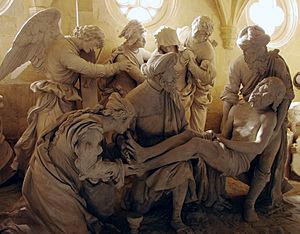Ligier Richier facts for kids

Ligier Richier (around 1500–1567) was a famous French sculptor. He created amazing artworks, mostly in the area of Saint-Mihiel in northeastern France.
Richier mainly worked for churches in his hometown of Saint-Mihiel. From 1530, he had the support of Duke Antoine of Lorraine, who was a very important patron. Richier sometimes carved in wood, but he really loved working with a soft, pale limestone. This stone came from local quarries. He developed special ways to polish the stone, making it look like shiny marble.
One of his most famous pieces is the "Groupe de la Passion." This artwork has 13 life-size figures carved from local stone. You can see it in the Church of St. Étienne. Another important work is "Le Transi de René de Chalon" (The Transi of René of Chalon). This sculpture is 1.74 meters tall and is in the church of Saint-Étienne in Bar-le-Duc.
Ligier Richier's Life and Art
Not much is known about Ligier Richier's early life. Some people think he was born near Commercy, but there is also evidence he was born in Saint-Mihiel. The people from Saint-Mihiel are called "Sammiellois."
Moving for His Beliefs
In 1560, Richier and others in Saint-Mihiel asked the Duke of Lorraine if they could practice their Protestant religion. It seems they were not allowed to. So, in 1564, Richier moved to Geneva, Switzerland. He joined his daughter Bernadine there. She had married Pierre Godart, another Protestant who left Lorraine because of his religious beliefs. Richier stayed in Geneva until he passed away in 1567.
His Special Art Style
Ligier Richier was known for creating powerful sculptures about the "Passion of Christ." These artworks often showed scenes like the crucifixion (calvaries), Mary mourning Jesus (pietàs), and Jesus being placed in the tomb (mise au tombeau).
He made several important sculptures for churches:
- Calvaries for the church in Briey and Saint-Étienne's church in Bar-le-Duc.
- A famous "mise au tombeau" for the Saint-Étienne church in Saint-Mihiel.
- A pietà for a church in Étain.
- A sculpture of the Virgin Mary fainting for Saint-Michel's church in Saint-Mihiel.
Richier also created sculptures for tombs. One famous example is the statue on the tomb of René de Chalon. René de Chalon was a prince who died in 1544. This sculpture is in the church of Saint-Étienne in Bar-le-Duc. He also made a sculpture for the tomb of Philippa de Gueldres in Pont-à-Mousson.
See also
 In Spanish: Ligier Richier para niños
In Spanish: Ligier Richier para niños
- Sculptures by Ligier Richier

